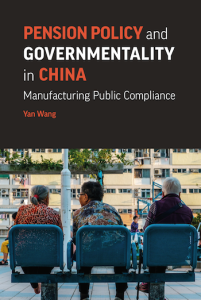In Pension Policy and Governmentality in China: Manufacturing Public Compliance, Yan Wang considers how China has maintained consistent public compliance while effecting major pension reforms to advance the state’s growth agenda. Wang’s deft mixed-methods approach makes for an insightful examination of state-society relations and authoritarian resilience in China, writes Xian Huang.
Pension Policy and Governmentality in China: Manufacturing Public Compliance. Yan Wang. LSE Press. 2022.
This book is available Open Access from LSE Press.
 How does the Chinese Communist Party secure the benefits of modernisation brought by social and economic reform without rousing the radical challenges that might subvert its authority? Yan Wang’s book Pension Policy and Governmentality in China sheds light on this critical question by examining the “governmentality” that works as the means – information management, benefit distribution, and coercion, among many others – whereby the Chinese party-state maintains its rule in the period of rapid social and economic transformation. This issue has become more relevant since 2014 when China entered the “new normal” characterised by slower economic growth and rapid population ageing under tightened political control. In the new era, the Chinese government has stringent financial and information constraints but prominent challenges to legitimation. By bringing in “the active consent role of the public” (14) in addition to the state’s ruling strategy and action, Pension Policy and Governmentality in China provides a two-way story of governance to advance our understanding of the authoritarian resilience in China.
How does the Chinese Communist Party secure the benefits of modernisation brought by social and economic reform without rousing the radical challenges that might subvert its authority? Yan Wang’s book Pension Policy and Governmentality in China sheds light on this critical question by examining the “governmentality” that works as the means – information management, benefit distribution, and coercion, among many others – whereby the Chinese party-state maintains its rule in the period of rapid social and economic transformation. This issue has become more relevant since 2014 when China entered the “new normal” characterised by slower economic growth and rapid population ageing under tightened political control. In the new era, the Chinese government has stringent financial and information constraints but prominent challenges to legitimation. By bringing in “the active consent role of the public” (14) in addition to the state’s ruling strategy and action, Pension Policy and Governmentality in China provides a two-way story of governance to advance our understanding of the authoritarian resilience in China.
[In] 2014 China entered the ‘new normal’ characterised by slower economic growth and rapid population ageing under tightened political control.
Under the state-individual interaction framework developed in Chapter 1, Wang examines how the Chinese party-state manufactures the public’s compliance and the constraints it implies for state governance’s effectiveness and legitimacy reproduction. Meanwhile, she explores how citizens can find room for counter-movement and how this shapes the state’s choices. She argues that the party-state faces two prominent constraints in ruling society: resource constraint and information asymmetry. Given this, it chooses a hybrid solution that includes both tolerant approaches – benefit distribution, propaganda, and education – and intolerant approaches – censorship and coercion – to maximise compliance from the citizens. Wang considers the tolerant and intolerant approaches as strategic substitutes or complements depending on the party-state’s objective, priority, and constraints. She constructs Chinese governmentality as a dynamic process in which the equilibrium point of various governing approaches shifts with state capacity, constraint, and public compliance. This way, the book gives us a powerful lens through which to see the complexity of governmentality. The book uses three empirical chapters (Chapters 2-4) to illustrate governmentality and assess its impacts on public compliance in the case of China’s pension reforms between 1978 and 2009.
The historical institutional analysis of China’s pension system in Chapter 2 reveals the state’s differentiated benefit allocation: the core elites (eg, government employees) have consistently enjoyed the most generous benefits while the urban formal employees (eg, State-Owned Enterprise [SOE] and public institution employees) have seen their pension schemes retrenched or modified to reduce the state’s fiscal burden; meanwhile, the state provided modest or slender benefits to the other social groups that could be bought off with minimal costs (eg, peasants, rural residents, and migrant workers). The variation of welfare benefits is “systematically designed to provide different social groups with different programs to maintain a balance of loyalty as well as avoid the risk of any hostile coalition” (30). This argument aligns well with my findings about the Chinese government’s healthcare provision and can be applied to other distributive policies in China. Notably, the differentiated allocation of social benefits contradicts the party-state’s previous claim on the “creation of a socialist egalitarian society” (12) characterised by work-unit-based and localised welfare provision before 1978, potentially endangering its legitimacy.
To avoid a legitimacy crisis, the party-state sought to reconstruct public knowledge and expectations of redistributing pension benefits and allocating welfare responsibility.
To avoid a legitimacy crisis, the party-state sought to reconstruct public knowledge and expectations of redistributing pension benefits and allocating welfare responsibility between the state and individuals through propaganda. Chapter 3 leverages text data from Chinese official newspapers to demonstrate how the state justified benefit differentiation and promoted the contributory public pension schemes according to the most salient issues in China’s social and economic reform (eg, SOE reform, demographic control, urbanisation). The text analysis demonstrates that the Chinese party-state shaped public knowledge and expectations regarding benefit redistribution and welfare responsibility by reiterating the principles of “contribution and rewards” and “rights and obligations” and moral arguments from traditional Chinese culture. More interestingly, it finds that the suggestions and persuasions in official discourse commonly appeal to “us” without clearly “action initiators” (89), indicating that the party-state sought to reconstruct subjectivity among citizens who were encouraged to see themselves as self-motivated, self-regulated, and self-sufficient in building up pension provision.
Contributory pension insurance for urban enterprise employees […] decreased the public’s perception of government responsibility for elderly welfare.
How did citizens react to the “shared” welfare responsibility constructed and promoted by the state during pension reforms? Chapter 4 uses individual-level survey data and takes advantage of the staggered pilot of urban enterprise employee pension insurance among Chinese provinces to examine the causal effects of contributory pension and policy propaganda on individuals’ attitudes towards welfare responsibility and political trust. The findings are twofold. First, the contributory pension insurance for urban enterprise employees, which was rolled out as policy experimentation in urban areas, generally decreased the public’s perception of government responsibility for elderly welfare. Second, local governments’ propaganda to maintain the government’s good image in welfare provision and responsibility enhanced the public’s perception of government responsibility for social welfare and the public’s political support, but only in the short term. These findings suggest that the public recognised the disjunction of policy content and propaganda, which led to a decrease in the perceived credibility of the governments in the long term. The public’s positive or negative reaction to the party-state’s knowledge construction through information control and force is further investigated and discussed outside the case of China’s pension reforms in Chapter 5, which combines participant observation and in-depth interviews.
The public recognised the disjunction of policy content and propaganda, which led to a decrease in the perceived credibility of the governments in the long term.
In short, Yan Wang’s book Pension Policy and Governmentality in China greatly contributes to the literature on governance, public compliance, and state-society relations. In particular, her skillful use of mixed methods to examine and explain the trajectories, policy rationale, and effects of China’s pension reforms set a strong example for students of China studies and social sciences.
Note: This review gives the views of the author, and not the position of the LSE Review of Books blog, or of the London School of Economics and Political Science.
Main Image: B.Zhou on Shutterstock.







